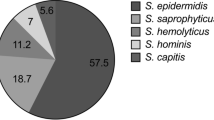Abstract
The ability ofStaphylococcus epidermidis to produce biofilm was compared in 147 clinically significant strains repeatedly isolated from blood cultures of patients with bloodstream infection and in 147 strains isolated from skin. The strains were examined for the presence ofica operone, for the ability to form biofilm by Christensen’s test-tube method and for the production of slime by Congo Red agar method. Theica operone was found in 92 (62.6 %) blood isolates and in 44 (29.9) isolates from skin. Christensen’s test-tube method was positive in 79 (53.7) and 33 (22.4), Congo Red agar method in 64 (43.5) and 31 (21.1) of blood and skin isolates, respectively. All three methods were more frequently positive in clinically significant isolates from blood than in strains isolated from skin. The detection ofica operone and the Christensen’s test-tube method showed better correlation with the clinical significance than the Congo Red agar method.
Similar content being viewed by others
References
Baldassarri L., Simpson W.A., Donelli G., Christensen G.D.: Variable fixation of staphylococcal slime by different histochemical fixatives.Eur.J.Clin.Microbiol.Infec.Dis. 12, 866–868 (1993).
Christensen G.D., Simpson W.A., Bisno A.L., Beachey E.H.: Adherence of slime-producing strains ofStaphylococcus epidermidis to smooth surfaces.Infect.Immun. 37, 318–326 (1982).
Costerton J.W., Stewart P.S., Greenberg E.P.: Bacterial biofilms: a common cause of persistent infections.Science 284, 1318–1322 (1999).
von Eiff C., Heilmann C., Peters G.: New aspects in the molecular basis of polymer-associated infections due to staphylococci.Eur.J.Clin.Microbiol.Infect.Dis. 18, 843–846 (1999).
Frebourg N.B., Lefebvre S., Baert S., Lemeland J.F.: PCR-based assay for discrimination between invasive and contaminatingStaphylococcus epidermidis strains.J.Clin.Microbiol. 38, 877–880 (2000).
Preeman D.J., Falkiner F.R., Keane C.T.: New method for detecting slime production by coagulase negative staphylococci.J.Clin.Pathol. 42, 872–874 (1989).
Hsu J.C., Nelson B.: Multiple comparisons in the general linear model.J.Comput.Graphic.Statist. 7, 23–41 (1998).
Knobloch J.K., Horstkotte M.A., Rohde H., Mack D.: Evaluation of different detection methods of biofilm formation inStaphylococcus aureus.Med.Microbiol.Immunol. 191, 101–106 (2002).
Lewis K.: Riddle of biofilm resistance.Antimicrob.Agents Chemother. 45, 999–1007 (2001).
Mack D., Fischer W., Krokotsch A., Leopold K., Hartmann R., Egge H., Laufs R.: The intercellular adhesin involved in biofilm accumulation ofStaphylococcus epidermidis is a linear β-1,6-linked glucosaminoglycan: purification and structural analysis.J.Bacteriol. 178, 175–183 (1996).
Martineau F., Picard F.J., Roy P.H., Ouellette M., Bergeron M.G.: Species-specific and ubiquitous DNA-based assays for rapid identification ofStaphylococcus epidermidis.J.Clin.Microbiol. 34, 2888–2893 (1996).
Mulder J.G., Degener J.E.: Slime-producing properties of coagulase negative staphylococci isolated from blood cultures.Clin.Microbiol.Infect. 4, 689–694 (1998).
O’Gara J.P., Humphreys H.:Staphylococcus epidermidis biofilms: importance and implications.J.Med.Microbiol. 50, 582–587 (2001).
Paterson R.L., Webster N.R.: Sepsis and the systemic inflammatory response syndrome.J.Roy.Coll.Surg.Edinburgh 45, 178–182 (2000).
Raad I.: Intravascular-catheter-related infections.Lancet 351, 893–898 (1998).
Sherertz R.J., Raad I.I., Belani A., Koo L.C., Rand K.H., Pickett D.L., Straub S.A., Fauerbach L.L.: Three-year experience with sonicated vascular catheter cultures in a clinical microbiology laboratory.J.Clin.Microbiol. 28, 76–82 (1990).
Vandecasteele S.J., Peetermans W.E., Merckx R.R., Rijnders B.J., Van Eldere J.: Reliability of theica, aap andatlE genes in the discrimination between invasive, colonizing and contaminantStaphylococcus epidermidis isolates in the diagnosis of catheter-related infections.Clin.Microbiol.Infect. 9, 114–119 (2003).
Vogel L., Sloos J.H., Spaargaren J., Suiker I., Dijkshoorn L.: Biofilm production byStaphylococcus epidermidis isolates associated with catheter related bacteremia.Diagn.Microbiol.Infect.Dis. 36, 139–141 (2000).
Woznicová V., Votava M., Skalka B.: Comparison of 2 methods of detecting slime production by coagulase-negative staphylococci. (In Czech)Epidemiol.Mikrobiol.Imunol. 42, 51–53 (1993).
Xu K.D., McFeters G.A., Stewart P.S.: Biofilm resistance to antimicrobial agents.Microbiology 146, 547–549 (2000).
Author information
Authors and Affiliations
Corresponding author
Additional information
This work was supported by grant no. 6818-3/2001 from theInternal Grant Agency of the Ministry of Health of the Czech Republic.
Rights and permissions
About this article
Cite this article
Růžička, F., Holá, V., Votava, M. et al. Biofilm detection and the clinical significance ofStaphylococcus epidermidis isolates. Folia Microbiol 49, 596–600 (2004). https://doi.org/10.1007/BF02931540
Received:
Revised:
Issue Date:
DOI: https://doi.org/10.1007/BF02931540




